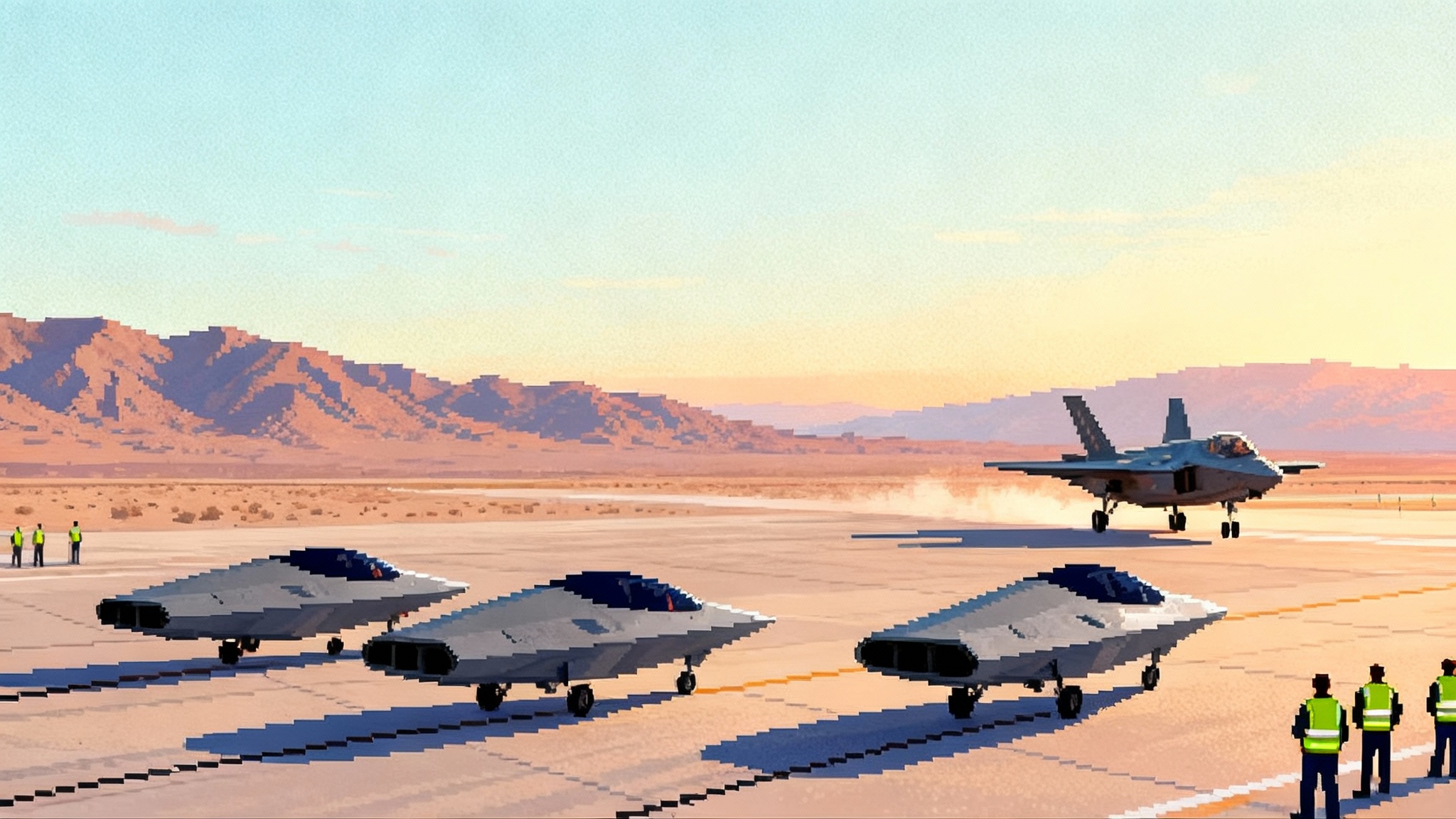EA-37B’s first sortie and export signal a new EW era
On May 2, 2025 the EA-37B flew its first mission-training sortie at Davis-Monthan AFB. By July 21, Italy had inked a deal for two aircraft. Together these moves signal electronic attack shifting to smaller, faster, longer-range jets built for stand-off jamming.

From test card to training sortie
On May 2, 2025 the 43rd Electronic Combat Squadron walked out to a gleaming white business jet in Tucson’s morning light and finally did what the community had waited years to do: fly the first mission-training sortie of the EA-37B Compass Call at Davis-Monthan Air Force Base. The base’s official account recorded the moment as the aircraft entered formal unit training with the 55th Electronic Combat Group, marking the shift from developmental work to day-in, day-out operations. The milestone is documented by the Air Force’s release on the first mission training sortie.
Two and a half months later, the export story arrived. On July 21, 2025 Italy signed a contract for two aircraft equipped for the Compass Call mission, the first foreign sale of the EA-37B architecture. L3Harris announced the deal as the first U.S.-approved international transfer of this capability, confirming the date and scope of Rome’s buy in its release that Italy signed a contract for two.
Why it matters: those two events illustrate a wider shift in airborne electronic attack toward smaller, faster, higher-flying jets that can loiter far from harm yet reach deep into the enemy’s electromagnetic ecosystem.
Why Compass Call moved to a jet
The EA-37B rehosts the Compass Call mission from the EC-130H to a modified Gulfstream G550. The rationale is straightforward:
- Faster climb, higher cruise, longer range. A modern business jet gets on station quicker, operates above weather, and holds at long stand-off distances while sipping fuel.
- Lower sustainment burden. Fewer engines, a smaller crew, and more automation cut operating and support costs, with reliability that keeps the jet on the line.
- Better survivability. Altitude, speed, and range give options to avoid threat rings while still creating effects.
What it jams and why that matters
Compass Call is a stand-off electromagnetic attack system designed to deny, degrade, or disrupt an adversary’s networks without penetrating dense surface-to-air missile belts. The target set goes beyond a simple radio jammer stereotype. Effects are tuned for the opponent’s C5ISRT architecture: the voice and data links that task shooters, the sensor-fusion pathways that build the picture, the control links for loitering munitions and drones, and the timing and navigation services that keep formations and fires synchronized.
Positioning, navigation, and timing (PNT) is a special case. Precision warfare runs on timing. Distort or deny PNT and you erode accuracy for artillery, missiles, and unmanned systems, injecting doubt into decision cycles. Doing this from a high, fast, long-range platform multiplies the effect.
Baseline 3 now, Baseline 4 with SABER next
The first tranche of EA-37Bs carries a rehosted Compass Call suite known as Baseline 3. Think of it as the proven EC-130H playbook migrated to a jet, with digital back-end upgrades and better precision. It is also a major reduction in size, weight, and power to fit the G550.
The next step, Baseline 4, opens the architecture around SABER (Small Adaptive Bank of Electronic Resources). SABER moves more of Compass Call’s brains from fixed hardware to software-defined radios and modular apps. The payoff is speed of adaptation: faster integration of third-party applications, new modes, and fresh waveforms without ripping out racks. Baseline 4 also scales to engage multiple targets and improves performance in dense signal environments.
Italy’s buy shows allies want stand-off EW
Italy’s July 21 agreement builds on years of G550-based special-mission investments, including surveillance and airborne early warning variants. Adding Compass Call-style electronic attack gives Rome a tool that fits both NATO and national concepts. It integrates with existing G550 training, maintenance, and basing and complements the alliance’s mix of F-35s and EA-18G Growlers.
For NATO, the value is obvious. A stand-off jammer with long legs can orbit outside adversary air defenses and still reach deep into the electromagnetic battlespace. In the Baltic or Black Sea regions, that means more options to blind targeting networks, disrupt drone control links, and scramble data flows that feed integrated air defenses.
Fitting into Indo-Pacific SEAD and DEAD concepts
The Indo-Pacific puts a premium on range, persistence, and survivability. A high-altitude, long-endurance jammer that can sit outside and reach in is a building block, not a luxury. Pairing EA-37Bs with F-35s, EA-18Gs, MALD-class decoys, long-range shooters, and collaborative combat aircraft creates multiple dilemmas for an adversary’s kill chain. For context, see how the land-based deep strike trend is evolving in Typhon in Japan deep strike and how autonomy is maturing in USAF autonomous wingmen fly.
Basing and the road to IOC
The EA-37B community is centered at Davis-Monthan AFB under the 55th Electronic Combat Group, which reports to the 55th Wing at Offutt AFB. Mission aircrews, maintainers, and intelligence specialists are building tactics and training there, with the first operational aircraft arriving in August 2024 to start pilot instruction. The May 2, 2025 milestone moved the jet from test cards into squadron training. Planning points to an initial operational capability around 2026, aligned with Baseline 4 and the maturing of logistics and simulators. Ten U.S. aircraft are planned to give the group critical mass.
Italy’s pair will follow a similar pipeline with contractor-led modification and government flight test before squadron operations. Because the aircraft sit on a widely used commercial platform, infrastructure demands are modest, which accelerates the path from contract to useful operational availability.
What stand-off EA does to an opponent’s C5ISRT
Think in layers:
- Sensing layer. Jamming degrades radar or forces less efficient modes, creating gaps and lowering detection ranges.
- Data layer. Corrupted or denied radio and data links slow updates, making target tracks stale and delaying shooters.
- Timing layer. PNT disruption reduces precision, sends unmanned systems off plan, and desynchronizes fires.
- Human layer. Incomplete information drives hesitation, opening windows for SEAD and DEAD packages while defenses are distracted.
From outside lethal envelopes, a jet like the EA-37B can maintain pressure for hours and pivot between target sets as the fight evolves. These effects compound when connected into resilient networks like the Pentagon’s LEO mesh network.
Risks the program must manage
- Spectrum deconfliction. Dense friendly emitters demand careful choreography to avoid fratricide, plus better electromagnetic battle management tools.
- EW workforce depth. A software-centric architecture raises the bar for mission crew training, threat analysis, and rapid reprogramming. Retention matters as much as recruiting.
- Export controls and classification. The power lies in techniques, not just hardware. Each export must balance releasability and configuration control.
- Concurrency risk. Fielding Baseline 3 while finishing Baseline 4 means training and sustainment must span two standards for a time. Tooling and simulators can manage this with disciplined change control.
- Integration with joint kill webs. The aircraft’s value rises when tightly wired into multi-domain tasking and assessment with reliable connectivity in contested conditions.
The bottom line
The EA-37B’s first training sortie in early May and Italy’s contract in late July signal that electronic attack is breaking out of legacy constraints. A stand-off jammer on a small, fast jet changes the geometry of the electromagnetic fight. It pressures an opponent’s C5ISRT and PNT without exposing crews to the densest air defenses, while cutting the cost of keeping the mission in the air compared to four-engine turboprops. Baseline 3 gets that future on the ramp now. Baseline 4 with SABER turns the jet into a software-first effects machine next. The electromagnetic spectrum rewards compounding improvements, and they are arriving just in time.








